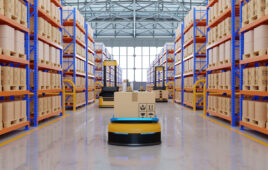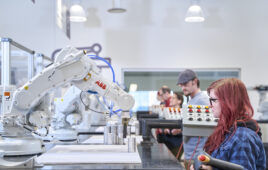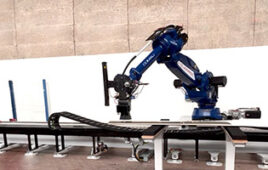Reshoring continues to make inroads in the American manufacturing sphere. While speaking with a robotics expert recently, he remarked how the cheaper and easier-to-program industrial robots now available are bringing production costs much lower. Low enough, in fact, that in some industries, smaller manufacturers can effectively compete with the low labor cost countries overseas.
The International Economic Development Council recently interviewed senior leaders of American firms about why they were reshoring. Reasons included:
- Labor turnover, training, and costs
- Practical economics
- Quality assurance
- Speed to market
- Flexibility in inventory, and Customer demand
Companies found that it was easier to manage a domestic staff as they were able to be more involved in company operations instead of relying on managers in other countries. Conversations can occur more regularly with fewer communication obstacles. There’s also an ability to decrease the mount of time that management spends traveling … and managers are able to work closer with and train new employees more easily.
Another factor was an increase in expenses related to manufacturing overseas. These companies found cost-competitiveness of production offshore had declined based on increased costs to ship products, the decline in the cost of gas, and increasing labor wages demanded by workers.
“As companies experienced a decline in the tax rebates offered by other countries, low-interest rates, competitive exchange rates, and attractive incentives became attractive to companies considering reshoring,” said Gene DePrez, Managing Partner of Global Innovation Partners and Visiting Senior Fellow of IEDC.
Some of the companies interviewed indicated that they experienced issues with quality controls for products manufactured offshore—and there were some inaccuracies in the products. Not surprisingly, the reshored products were found to be of higher-quality meeting expectations.
The IEDC also noted that the movement of goods faces many potential delays from the time the product leaves the factory to the time it is received by the end user.
“Natural disasters can delay the delivery of products for significant periods of time just as man-made delays can occur including labor disputes and human error. A product is produced to its customer leaves less room for delays and faster turnaround times from order to delivery,” said DePrez.
 For companies thinking about returning operations to the U.S., there are some free tools that the government and NPOs have created several. Check out Access Costs Everywhere (acetool.commerce.gov), U.S. Cluster Mapping Tool (www.clustermapping.us), the National Excess Manufacturing Capacity Catalog (www.edastayusa.org) and the Reshoring Initiative’s Total Cost of Ownership Estimator (http://www.reshorenow.org/TCO_Estimator.cfm). IEDC also said that a conversation with the economic development organization located in your community or state can be a good starting place.
For companies thinking about returning operations to the U.S., there are some free tools that the government and NPOs have created several. Check out Access Costs Everywhere (acetool.commerce.gov), U.S. Cluster Mapping Tool (www.clustermapping.us), the National Excess Manufacturing Capacity Catalog (www.edastayusa.org) and the Reshoring Initiative’s Total Cost of Ownership Estimator (http://www.reshorenow.org/TCO_Estimator.cfm). IEDC also said that a conversation with the economic development organization located in your community or state can be a good starting place.
Paul J. Heney – Editorial Director
[email protected]
On Twitter @DW_Editor
Filed Under: Commentaries • insights • Technical thinking, Robotics • robotic grippers • end effectors





Thank you for mentioning the Reshoring Initiative!
We agree that companies are recognizing that with the use of the refined metrics of total cost of ownership (TCO) to uncover the hidden costs and risks of offshoring and reducing costs with sustainable strategies such as robotics, lean, improved product design, and automation they can increase competitiveness and manufacture in the U.S. profitably.
The bleeding of manufacturing jobs to offshore has stopped. Reshoring, including FDI, balanced offshoring in 2015 as it did in 2014. In comparison, in 2000-2007 the United States lost net about 200,000 manufacturing jobs per year to offshoring. That is huge progress to celebrate!
The smart economy will enable reshoring of U.S. manufacturing. We were trying to make everything as cheap as possible (offshoring to China). It is better now to compete by making things as smart as possible. The U.S. is well equipped for “smart innovation” a key competitive edge.
The winning strategy is balancing the trade deficit with a strong investment in automation and skills training and increased corporate use of Total Cost for sourcing and plant siting decisions. A competitive USD and corporate tax rates would accelerate the process.
The Reshoring Initiative Can Help
In order to help companies decide objectively to reshore manufacturing back to the U.S. or offshore, the not-for-profit Reshoring Initiative’s free Total Cost of Ownership Estimator (TCOE) can help corporations calculate the real P&L impact of reshoring or offshoring. http://www.reshorenow.org/TCO_Estimator.cfm
Reshoring Initiative Data Report: http://www.reshorenow.org/content/pdf/2015_Data_Summary.pdf
This is awesome! It is great to see a change in the offshoring of American jobs! This encourages the American manufacturing worker regarding employment. In addition, due to technological advancement, reshoring will also encourage a new set of technical skills workers will be required to possess.
Thank you for the article and thank you Sandy for the additional information.
Professor Bondoc